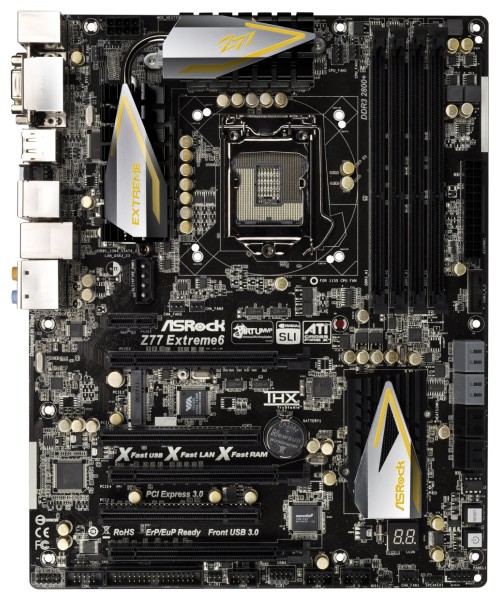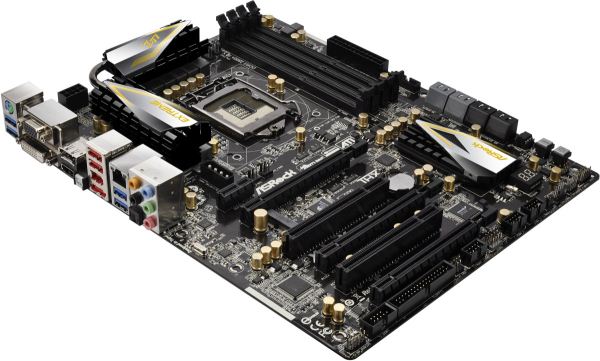Intel Z77 Panther Point Chipset and Motherboard Preview – ASRock, ASUS, Gigabyte, MSI, ECS and Biostar
by Ian Cutress on April 8, 2012 12:00 AM EST- Posted in
- Motherboards
- Intel
- Biostar
- MSI
- Gigabyte
- ASRock
- Asus
- Ivy Bridge
- ECS
- Z77
ASRock Z77 Extreme6—Visual Inspection
With the Extreme6, compared to the Extreme4, there are a significant number of changes, both visual and in terms of features. For a start, the heatsink design is more pronounced, using something similar to their X79 range in terms of black and gold ridged and edged surfaces. The VRM heatsink design is more substantial than the Extreme4, even though online it states it is still only an 8 + 4 VRM design—actually looking at the board, it seems more of a 10 + 4 design.
By looking at the motherboard, you would assume that it would support three-GPU setups. Unfortunately, this third full-length PCIe lane is only PCIe 2.0 x4, rather than splitting up the PCIe 3.0 lanes x8/x4/x4 or using a PLX chip. The MSRP for this board should be around $177, indicating that perhaps that is too cheap a board for one of the expensive PCIe 3.0 expansion PLX chips.

Onboard is also an mSATA port, right in the middle between the first PCIe slot and the PCI slot. Above the PCIe slots is a 4-pin molex power connector to provide extra power to the PCIe slots, although I am kind of getting tired of seeing it put in this location. If anything, it should be at the bottom end or beside the 24-pin power connector, as having it above the PCIe slots just means that there will be cables all over the place.
One other less obvious change to the Extreme4 is that there is a Floppy drive header on board. Yes, you heard me right—floppy drive! It seems odd now to include this legacy connection. It still has a place in industrial concepts (where a machine uses floppy drives and costs 1000x more than the PC processing its data), but not particularly on a higher end product which may be geared towards gaming and overclocking. Perhaps if ASRock are the only ones, then it creates a niche just for them.
In terms of fan headers on board, we have one three-pin beside the 8-pin 12V power connector, two CPU headers (one 4-pin, one 3-pin) just to the right of the top heatsink, two chassis three-pin headers beside the molex connector, and another 4-pin chassis header on the bottom of the board. On the right hand side, the USB 3.0 connector has been placed beneath the 24-pin ATX power connector, followed by the SATA ports. Like the Extreme4, we have the PCH SATA ports (two SATA 6 Gbps and four SATA 3 Gbps) and two extra SATA 6 Gbps from an ASMedia ASM1061 controller.
Around the larger chipset heatsink, we have power/reset buttons and a two digit debug display, both of which I personally like to see as a reviewer (makes my job a bit easier) but also helps overclockers. On the south side of the board, apart from that floppy connector I mentioned, we have a COM port, front panel audio, and an array of USB 2.0 headers.
PCIe layout is similar to the Extreme6, with a PCIe x1, PCIe 3.0 x16/x8, an mSATA connector, PCI, PCIe 3.0 x8, PCI, and a PCI 2.0 x4. This allows a user to use a dual GPU setup, and still have access to a PCIe x1 and x4.

Aside from the bowed picture from ASRock, we have something similar to the Extreme4 for the IO back panel, though this time with a DisplayPort output. From left to right, we have a combination PS/2 port, two USB 3.0 ports (blue), a D-Sub port, DVI-D, DisplayPort, HDMI, a ClearCMOS button, two USB 2.0 (red), an IEEE1394 port, eSATA, gigabit Ethernet, two more USB 3.0 (blue), and audio outputs including an optical SPDIF.
Board Features
| ASRock Z77 Extreme6 | |
| Size | ATX |
| CPU Interface | LGA-1155 |
| Chipset | Intel Z77 |
| Power Delivery | 8 + 4 |
| Memory Slots |
Four DDR3 DIMM slots supporting up to 32 GB Up to Dual Channel, 1066-2800 MHz |
| Video Outputs | DisplayPort, HDMI 1.4a, DVI-D, D-Sub |
| Onboard LAN | Broadcom BCM57781 |
| Onboard Audio | Realtek ALC898 |
| Expansion Slots |
2 x PCIe x16 Gen3 (x16, x8/8) 1 x PCIe x16 Gen2 (x4) 1 x PCIe x1 Gen2 2 x PCI 1 x mini PCIe |
| Onboard SATA/RAID |
2 x SATA 6 Gbps (PCH), Support for RAID 0, 1, 5, 10 2 x SATA 6 Gbps (ASMedia ASM1061) 4 x SATA 3 Gbps (PCH), Support for RAID 0, 1, 5, 10 |
| USB |
Two USB 3.0 at rear (PCH) Two USB 3.0 at rear (Etron EJ168A) One USB 3.0 header (PCH) |
| Onboard |
4 x SATA 6 Gbps 4 x SATA 3 Gbps 1 x Floppy Connector 1 x IR Header 1 x CIR Header 1 x COM Header 1 x SPDIF Header 1 x 4-pin Molex power connector Power/Reset Buttons Two Digit Debug LED 6 x Fan Headers Front panel audio connector 3 x USB 2.0 headers (support 6 USB 2.0 ports) 1 x USB 3.0 header (supports 2 USB 3.0 ports) |
| Power Connectors |
1 x 24-pin ATX connector 1 x 8-pin 12V connector 1 x 4-pin Molex for PCIe |
| Fan Headers |
2 x CPU Fan Header (one 4-pin, one 3-pin) 3 x CHA Fan Headers (one 4-pin, two 3-pin) 1 x SYS Fan Header (one 3-pin) |
| IO Panel |
1 x Combo PS/2 Port 1 x DisplayPort 1 x HDMI 1.4a 1 x DVI-D 1 x D-Sub 1 x Optical SPDIF 2 x USB 2.0 4 x USB 3.0 1 x IEEE1394 1 x Gigabit Ethernet 1 x Clear CMOS Audio Outputs |
| Warranty Period | 3 years from date of purchase |
| Product Page | Link |
Nothing immediately jumps out from the board features list aside from the differences to the Extreme4. This is a quite good package for an MSRP of $171.











145 Comments
View All Comments
Zoomer - Tuesday, April 10, 2012 - link
So when is AMD buying them out and integrating this in their gfx cards / platform?neo55 - Sunday, April 8, 2012 - link
Will Z77 support two or three monitors simultaneously?GreenEnergy - Sunday, April 8, 2012 - link
You mean from the Ivy Bridge IGP?Well depends. (Its the same btw for H77, Z75 and Z77 etc.). You need to have 2 displayport if I remember correctly. So if you got for example DVI, HDMI and DP. Then 2 screens only. If you got DVI, DP, DP then 3. Or if you daisychain the DP?
dubyadubya - Sunday, April 8, 2012 - link
Listing fan header count and layout is useless if you do not test the functionality. Do they report RPM? Can they control fan speed? Does the fan control work with Speedfan etc. or only the software from the motherboard manufacturer? Several years ago many people including myself brought this to Anandtech's attention. At the time Anandtech stated they would include this missing info which they did. Trouble is the info was only included in one or two reviews before it was dropped. When I purchase a new motherboard I want to know this info. I have spent many hours searching for this info for each new build as most manufactures do not give detailed info even in the motherboard manual.IMO if a fan header exists it must have full functionality. If not the header should not be on the board. Motherboard manufactures need to pull their heads out of their asses. If Anandtech reported this info in reviews and gave negative reviews on boards with poor fan support the manufacturers would get the hint.
Nje - Sunday, April 8, 2012 - link
Yeah I would love to know this, particularly if the fan headers can control 3 pin fans as well (ie vary the voltage).ASUSTechMKT - Monday, April 9, 2012 - link
Primary CPU headers ( CPU and CPU OPT are fully controllable for 4 pin ) as the majority of CPU coolers are PWM for chassis headers ( 1-4 all allow for 3 pin and 4 pin fan control ).Zoomer - Tuesday, April 10, 2012 - link
Asus, can they be used with speedfan or is it BIOS/Asus software only?ASUSTechMKT - Monday, April 9, 2012 - link
This has been noted in the last couple of reviews. Specifically for ASUS we have spent considerable time putting quality fan controls on our boards all headers allow for 3 presets as well as min and max rotation and target temperatures. In addition with our software for this generation we offer full calibration per each header that can sense the min and max rotation and provide this information as well as sync this data to the profiles. Overall it is quite extensive make sure to check out our videos coming up which shows it in great depth.Arbie - Monday, April 9, 2012 - link
@dubyadubya - Look on the bright side: at least one manufacturer (Asus) takes fans seriously, and at least one reviewer (Anandtech) is even mentionng the fact.I have the same wants as you do, and have made the same requests, but be reasonable. These aren't full motherboard reviews! They don't even have the boards operable, much less any hands-on time with BIOS details.
And when they do have all that, a higher priority will be PCIe lanes and how many graphics cards can be stuffed in. That's because you can't run any modern games with only one board.
But then they might talk a little more about the fan controls... Let's hope. Again - be glad that even one vendor is paying attention and has included some controls to be talked about.
Cavalcade - Sunday, April 8, 2012 - link
With a slightly more than passing knowledge of rendering, and having spent a fair amount of time handling input in a game engine, I'm curious as to how Lucid came to the responsiveness numbers in the chart on page 3. The concept seems valid at first glance, but the numbers strike me as pure marketing fodder as opposed to solid and testable results.Also, this sort of technology seems far better suited to residing in the driver layer as opposed to yet another piece of middleware for PC gamers to contend with. We're already effectively blocked from the hardware, and forced to go through third-party graphics APIs (Direct3D/OpenGL).
Maybe it's a "you have to see it (feel it)" kind of thing, but from here you can color me skeptical.